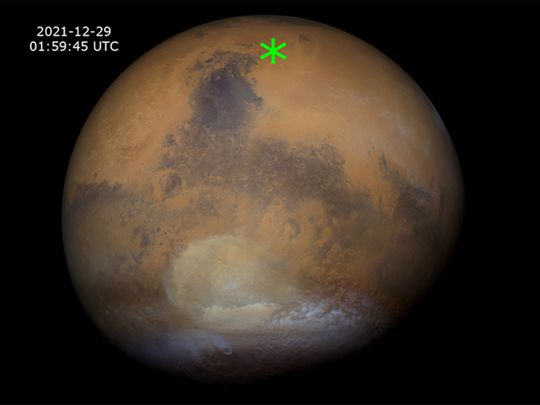
Dubai: The Emirates Mars Mission, the first interplanetary exploration undertaken by an Arab nation, is returning a number of unique observations of Martian dust storms, providing unparalleled depth of information and insight into the way in which these storms evolve and spread across huge swathes of the planet.
The Hope probe provides a powerful platform to observe details of the structure and variability of the Martian atmosphere. Coordinated observations made by the EXI camera and the EMIRS infrared spectrometer characterise the thermal state of the surface and lower atmosphere, and provide details of the geographic distribution of dust, water vapour, and water and carbon-dioxide ice clouds over time scales of minutes to days.
The EXI camera system collects images at three visible and two ultraviolet wavelengths – providing a multi-spectral “weather satellite view” of Mars. The colour composites presented here are assembled from images taken through EXI’s blue, green, and red filters (centred at 437, 546, and 635 manometers). These images are “calibrated” products which have removed many of the artefacts introduced by the camera system and also provide the observation geometry information to allow for mapping. The contrast has been adjusted to enhance the visibility of surface and atmospheric features.
What is EMIRS?
EMIRS is an interferometric thermal infrared spectrometer (operating in the 6-40 micron wavelength range) that complements EXI in characterising the lower atmosphere of Mars. EMIRS measurements are used to determine the distribution of lower atmospheric constituents such as dust, water ice and water vapour (presented here as optical depth - related to the amount of aerosols suspended in the atmosphere). In addition, Mars surface temperatures and atmospheric temperature profiles up to 50km from the surface are measured. The warming of the suspended dust by sunlight leads to the increased atmospheric temperatures, which are also detected by EMIRS.
Starting in late December 2021, EXI and EMIRS monitored a rapidly-evolving regional dust storm as it expanded to a size of over several thousand kilometres. A series of EXI and EMIRS “globes” documented the growth and dissipation of the storm over nearly two weeks.
As the Martian season approaches southern spring, dust storm activity typically becomes more pervasive. The Hope observatory is a valuable orbiting asset in documenting the location and evolution of dust storms on the planet, giving unprecedented observations and insight into the nature of these storms and their characterisation.











